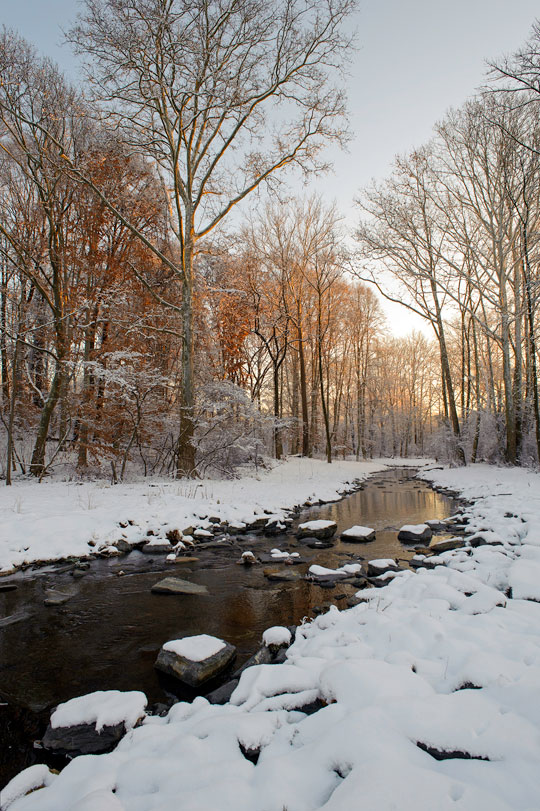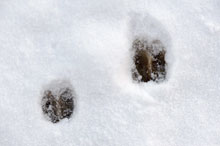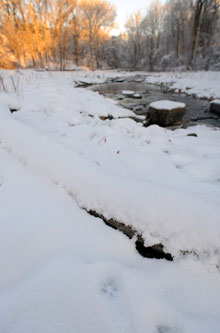 The first snow of winter sits heavy and wet as photographer Christian Hunold and I explore Morris Park by the rich light of dawn. The snow clings to every branch and twig, surrounding us in a tunnel of glowing white as we walk the path along the west branch of Indian Creek.
The first snow of winter sits heavy and wet as photographer Christian Hunold and I explore Morris Park by the rich light of dawn. The snow clings to every branch and twig, surrounding us in a tunnel of glowing white as we walk the path along the west branch of Indian Creek.
Overbrook’s Morris Park follows the two branches of the creek from City Avenue to Haverford Avenue, just upstream of their confluence with Cobbs Creek. In other seasons, I’ve caught toads in the underbrush and followed the trails to the top of one of the quarries, which today looks like a rocky cliff cut down into the hillside. Together with the ruined remains of old mills, it all hints at the land’s industrial past.
According to Dan Gasiewski, cofounder of the Morris Park Restoration Association, it took nearly a century of advocacy to ensure a more natural present and future for the park. Through the 1960s, neighbors fought off housing developments and anti-aircraft installations. Toward the end of the 1990s, though, the park had fallen into disrepair as involved neighbors either aged or moved away. The trails had been neglected, blocked by fallen trees and undercut by creeks that surged with runoff after storms.
 Evidence of white-tailed deer is seen in freshly fallen snow.Ten years ago, Dan and his brother, Tom, both Overbrook natives, started by pulling out invasive Japanese knotweed, and soon found themselves spearheading the rebirth of the park. The city responded by increasing maintenance, and the duo were able to use federal stimulus funds in 2010 to overhaul the trail system. More recently, the U.S. Army Corps of Engineers has been working just above Haverford Avenue to return the west branch of Indian Creek to its original above-ground course—a process called daylighting—helping to reduce flooding and improve the creek as an aquatic habitat. Together, the restoration association, the city and the Army Corps are working to get the park to a more natural state.
Evidence of white-tailed deer is seen in freshly fallen snow.Ten years ago, Dan and his brother, Tom, both Overbrook natives, started by pulling out invasive Japanese knotweed, and soon found themselves spearheading the rebirth of the park. The city responded by increasing maintenance, and the duo were able to use federal stimulus funds in 2010 to overhaul the trail system. More recently, the U.S. Army Corps of Engineers has been working just above Haverford Avenue to return the west branch of Indian Creek to its original above-ground course—a process called daylighting—helping to reduce flooding and improve the creek as an aquatic habitat. Together, the restoration association, the city and the Army Corps are working to get the park to a more natural state.
Aside from a crew working on the stream restoration project, Christian and I were the only creatures stirring in Morris Park, but paw prints scattered along the bank hinted at more. Mid-sized carnivore prints all look similar to me (Dog? Cat? Red fox? Grey fox?), but Christian identified them quickly. Later, from the cozy comfort of my apartment, I matched the arrowhead shape to the red fox description in a book of animal prints. The deer prints we saw on the main path were much easier to identify. I catch glimpses of foxes and deer now and then, but the prints, left over only a few hours of darkness, make it clear how common these animals are, even when they stay out of our view most of the day.
 The muted prints of a red fox run along Indian Creek in Morris Park.On a more recent outing, I found it much more difficult to identify prints left in drier, looser snow. Even though I quickly lost feeling in my toes as I tried to make sense of ambiguous tracks, the presence of them warmed my heart with the proof that something else was awake in the woods.
The muted prints of a red fox run along Indian Creek in Morris Park.On a more recent outing, I found it much more difficult to identify prints left in drier, looser snow. Even though I quickly lost feeling in my toes as I tried to make sense of ambiguous tracks, the presence of them warmed my heart with the proof that something else was awake in the woods.
Voles—small rodents with stubby little tails—tunnel beneath the snow. Foxes pace the floodplain hunting them, leaving behind their arrowhead prints, and white-tailed deer step through the woods looking for buds to nip off the ends of low branches, leaving behind the twin teardrops of their hooves.
Snow is undeniably beautiful, but has always struck me as sterile. The tracks, however, prove that life persists despite the freeze. The next time it snows, come out and leave some of yours as well.
Bernard Brown is an amateur field herper and bureaucrat. He writes about urban natural history and sustainable eating.
Photos by Christian Hunold.










wao its waesome snow i Love this plce